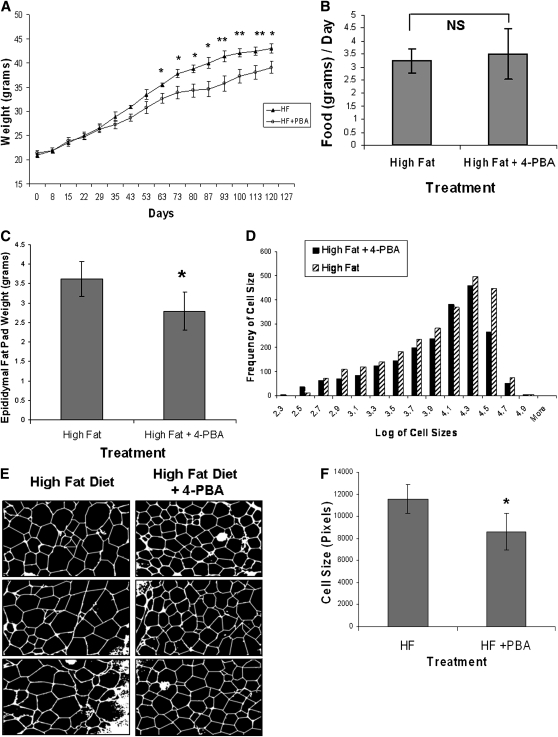Fig. 6.
Effect of 4-PBA on weight gain and adipogenesis in mice fed a high-fat diet. C57BL/6 mice were fed a high-fat diet supplemented without (n = 8) or with 4-PBA (n = 9) at a dose of 1g/kg/day. A: Effect of 4-PBA on weight gain. Starting at day 63 and for the remainder of the study, mice supplemented with 4-PBA had significantly lower body weights compared with controls (*P ≤ 0.05, **P ≤ 0.01 compared with the mice supplemented with 4-PBA using a rank sum test of significance; n = 8–9). B: Food intake measurements. No significant difference in food intake was noted between the two groups. C: Effect of 4-PBA on epididymal fat mass. Epididymal fat pads were removed at the conclusion of the study and weighed. Mice on the high fat + 4-PBA diet had significantly lower mean fat pad mass (*P < 0.01 using a rank sum test of significance; n = 8–9). D: Adipocyte cell size distribution from epididymal adipose tissue of C57BL/6 mice. The histograms represent the distribution of cell sizes in mice fed a high-fat diet with or without 4-PBA supplementation. The x axis represents the logarithm of cell sizes in pixels, while the y axis shows the frequency of a given cell size in the population of cells for each group of mice. E: Representative cross sections of epididymal fat pads. Images of the sectioned tissue were taken, and representative pictures from the two groups of mice are shown. F: Mean adipocyte size is reduced with 4-PBA supplementation. Mice fed a high-fat diet supplemented with 4-PBA had a significant reduction in average cell size compared with the high-fat diet alone group (*P < 0.05). For average cell size measurements, n = 5 for the high-fat group and n = 4 for the high-fat + 4-PBA group.

